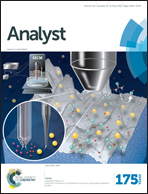Surface ligation-based resonance light scattering analysis of methylated genomic DNA on a microarray platform†
Abstract
DNA methylation is a crucial epigenetic modification and is closely related to tumorigenesis. Herein, a surface ligation-based high throughput method combined with bisulfite treatment is developed for analysis of methylated genomic DNA. In this method, a DNA microarray is employed as a reaction platform, and resonance light scattering (RLS) of nanoparticles is used as the detection principle. The specificity stems from allele-specific ligation of Taq DNA ligase, which is further enhanced by improving the fidelity of Taq DNA ligase in a heterogeneous reaction. Two amplification techniques, rolling circle amplification (RCA) and silver enhancement, are employed after the ligation reaction and a gold nanoparticle (GNP) labeling procedure is used to amplify the signal. As little as 0.01% methylated DNA (i.e. 2 pmol L−1) can be distinguished from the cocktail of methylated and unmethylated DNA by the proposed method. More importantly, this method shows good accuracy and sensitivity in profiling the methylation level of genomic DNA of three selected colonic cancer cell lines. This strategy provides a high throughput alternative with reasonable sensitivity and resolution for cancer study and diagnosis.


 Please wait while we load your content...
Please wait while we load your content...